Strategic Report: Verdant Leisures' Expansion into Singapore Market
VerifiedAdded on 2023/06/18
|10
|2965
|267
Report
AI Summary
This report provides a comprehensive analysis of Verdant Leisures, a UK-based travel and tourism company, and its potential expansion into the Singaporean market. The report examines the global business environment, key drivers influencing international expansion, and the rationale behind Verdant Leisures' decision to explore opportunities in Singapore. It includes a PESTEL analysis to assess political, economic, social, technological, environmental, and legal factors affecting the business. Furthermore, the report discusses the opportunities and challenges associated with global growth, evaluates relevant trade blocs and agreements, and considers tariff and non-tariff barriers in the international trading environment. The analysis aims to provide a strategic overview for Verdant Leisures to make informed decisions regarding its international market entry.
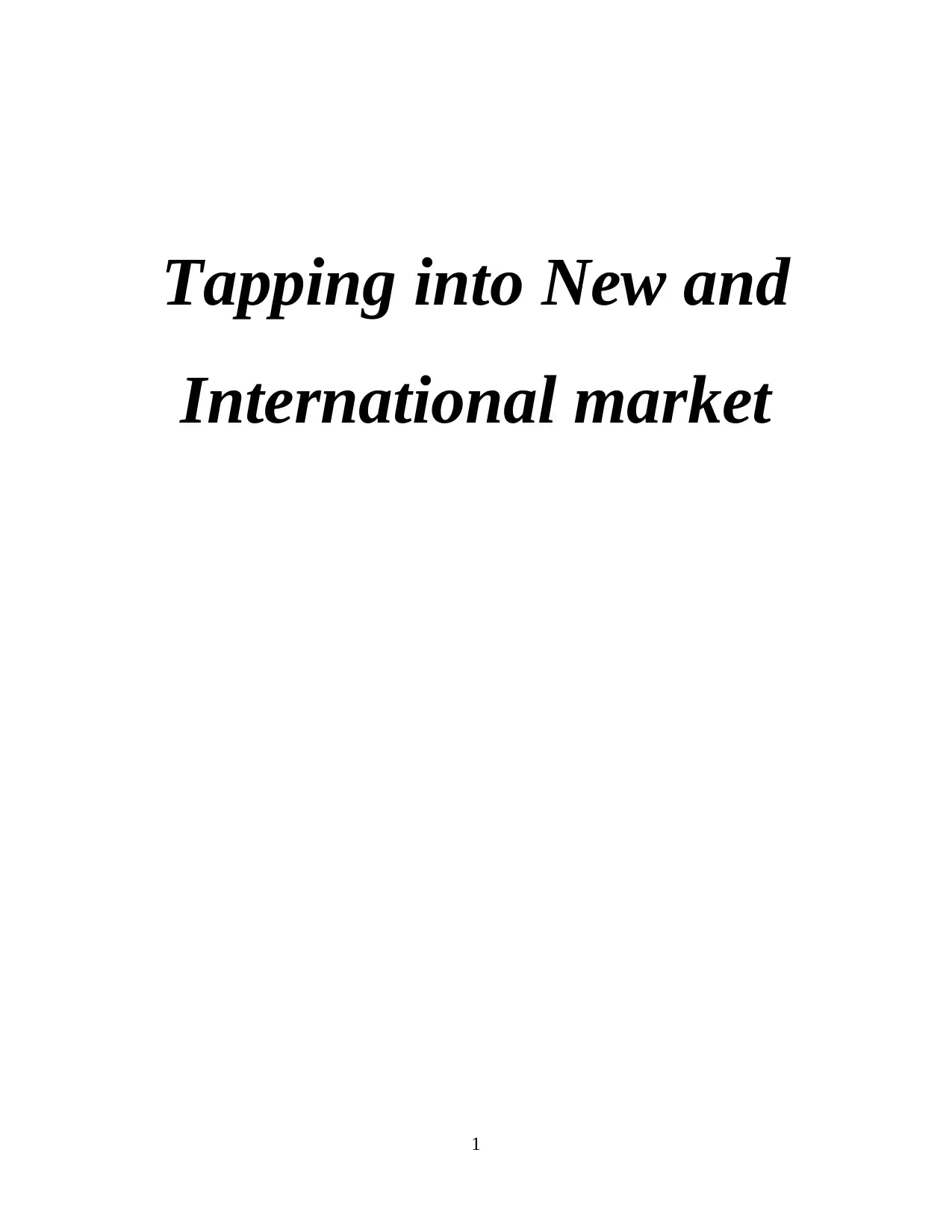
Tapping into New and
International market
1
International market
1
Paraphrase This Document
Need a fresh take? Get an instant paraphrase of this document with our AI Paraphraser
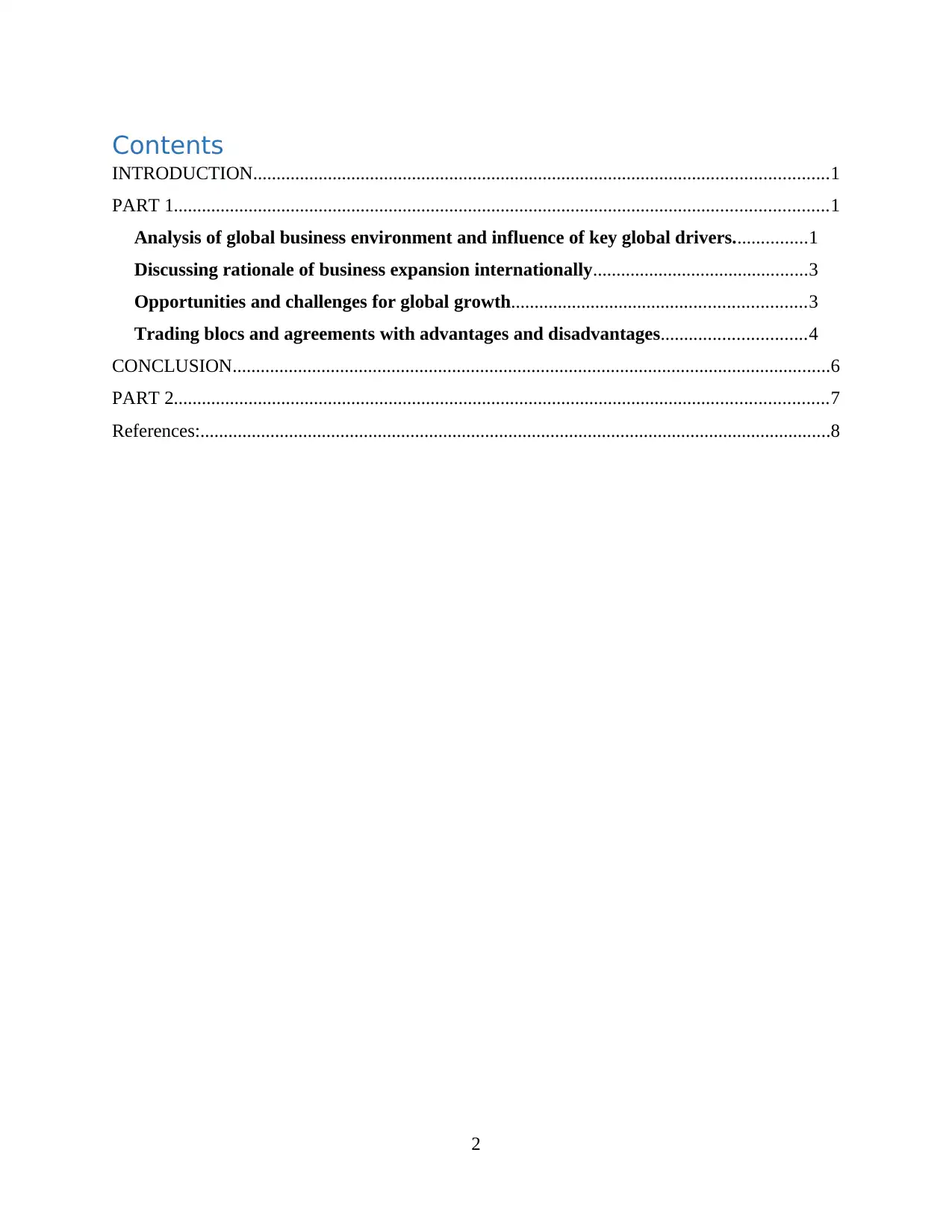
Contents
INTRODUCTION...........................................................................................................................1
PART 1............................................................................................................................................1
Analysis of global business environment and influence of key global drivers................1
Discussing rationale of business expansion internationally..............................................3
Opportunities and challenges for global growth...............................................................3
Trading blocs and agreements with advantages and disadvantages...............................4
CONCLUSION................................................................................................................................6
PART 2............................................................................................................................................7
References:.......................................................................................................................................8
2
INTRODUCTION...........................................................................................................................1
PART 1............................................................................................................................................1
Analysis of global business environment and influence of key global drivers................1
Discussing rationale of business expansion internationally..............................................3
Opportunities and challenges for global growth...............................................................3
Trading blocs and agreements with advantages and disadvantages...............................4
CONCLUSION................................................................................................................................6
PART 2............................................................................................................................................7
References:.......................................................................................................................................8
2
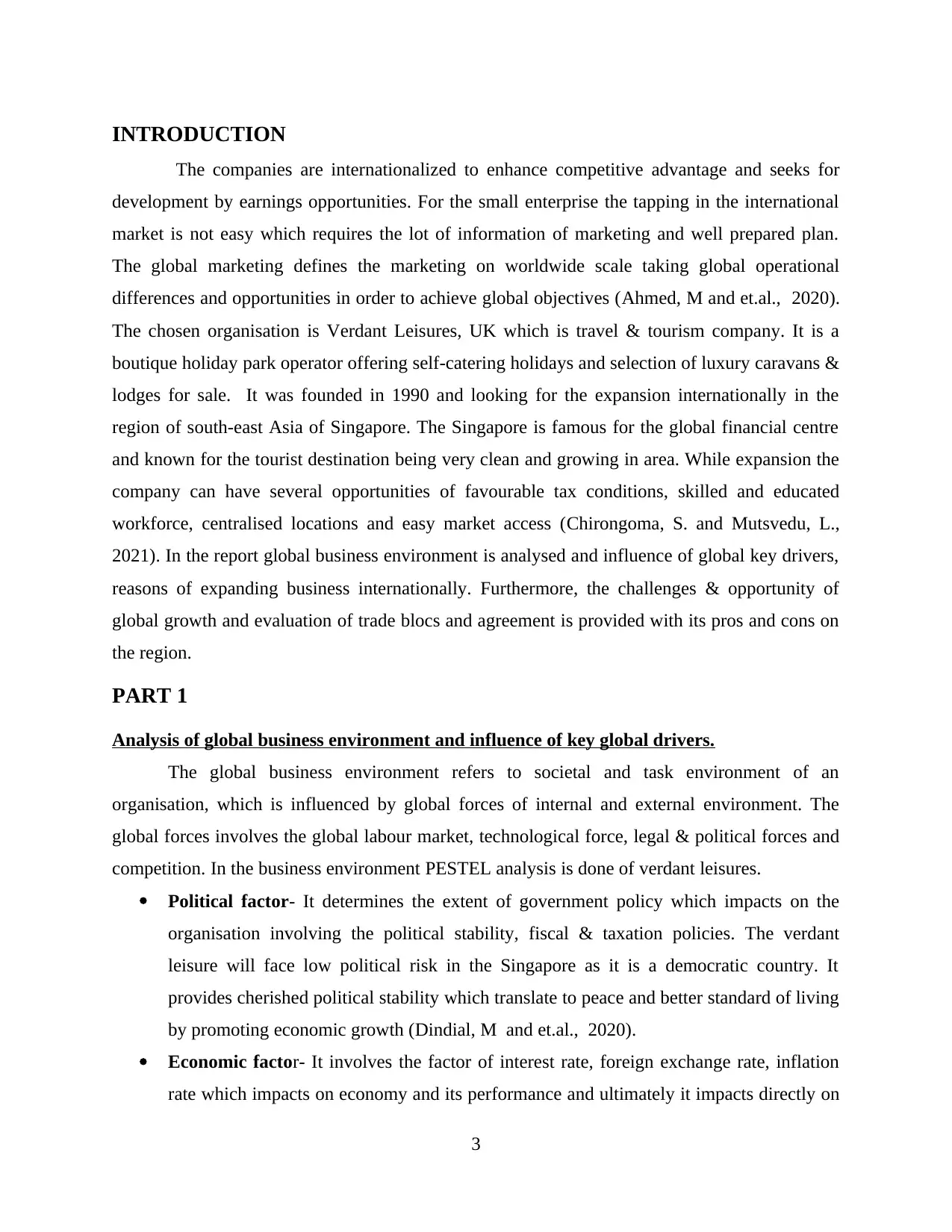
INTRODUCTION
The companies are internationalized to enhance competitive advantage and seeks for
development by earnings opportunities. For the small enterprise the tapping in the international
market is not easy which requires the lot of information of marketing and well prepared plan.
The global marketing defines the marketing on worldwide scale taking global operational
differences and opportunities in order to achieve global objectives (Ahmed, M and et.al., 2020).
The chosen organisation is Verdant Leisures, UK which is travel & tourism company. It is a
boutique holiday park operator offering self-catering holidays and selection of luxury caravans &
lodges for sale. It was founded in 1990 and looking for the expansion internationally in the
region of south-east Asia of Singapore. The Singapore is famous for the global financial centre
and known for the tourist destination being very clean and growing in area. While expansion the
company can have several opportunities of favourable tax conditions, skilled and educated
workforce, centralised locations and easy market access (Chirongoma, S. and Mutsvedu, L.,
2021). In the report global business environment is analysed and influence of global key drivers,
reasons of expanding business internationally. Furthermore, the challenges & opportunity of
global growth and evaluation of trade blocs and agreement is provided with its pros and cons on
the region.
PART 1
Analysis of global business environment and influence of key global drivers.
The global business environment refers to societal and task environment of an
organisation, which is influenced by global forces of internal and external environment. The
global forces involves the global labour market, technological force, legal & political forces and
competition. In the business environment PESTEL analysis is done of verdant leisures.
Political factor- It determines the extent of government policy which impacts on the
organisation involving the political stability, fiscal & taxation policies. The verdant
leisure will face low political risk in the Singapore as it is a democratic country. It
provides cherished political stability which translate to peace and better standard of living
by promoting economic growth (Dindial, M and et.al., 2020).
Economic factor- It involves the factor of interest rate, foreign exchange rate, inflation
rate which impacts on economy and its performance and ultimately it impacts directly on
3
The companies are internationalized to enhance competitive advantage and seeks for
development by earnings opportunities. For the small enterprise the tapping in the international
market is not easy which requires the lot of information of marketing and well prepared plan.
The global marketing defines the marketing on worldwide scale taking global operational
differences and opportunities in order to achieve global objectives (Ahmed, M and et.al., 2020).
The chosen organisation is Verdant Leisures, UK which is travel & tourism company. It is a
boutique holiday park operator offering self-catering holidays and selection of luxury caravans &
lodges for sale. It was founded in 1990 and looking for the expansion internationally in the
region of south-east Asia of Singapore. The Singapore is famous for the global financial centre
and known for the tourist destination being very clean and growing in area. While expansion the
company can have several opportunities of favourable tax conditions, skilled and educated
workforce, centralised locations and easy market access (Chirongoma, S. and Mutsvedu, L.,
2021). In the report global business environment is analysed and influence of global key drivers,
reasons of expanding business internationally. Furthermore, the challenges & opportunity of
global growth and evaluation of trade blocs and agreement is provided with its pros and cons on
the region.
PART 1
Analysis of global business environment and influence of key global drivers.
The global business environment refers to societal and task environment of an
organisation, which is influenced by global forces of internal and external environment. The
global forces involves the global labour market, technological force, legal & political forces and
competition. In the business environment PESTEL analysis is done of verdant leisures.
Political factor- It determines the extent of government policy which impacts on the
organisation involving the political stability, fiscal & taxation policies. The verdant
leisure will face low political risk in the Singapore as it is a democratic country. It
provides cherished political stability which translate to peace and better standard of living
by promoting economic growth (Dindial, M and et.al., 2020).
Economic factor- It involves the factor of interest rate, foreign exchange rate, inflation
rate which impacts on economy and its performance and ultimately it impacts directly on
3
⊘ This is a preview!⊘
Do you want full access?
Subscribe today to unlock all pages.

Trusted by 1+ million students worldwide
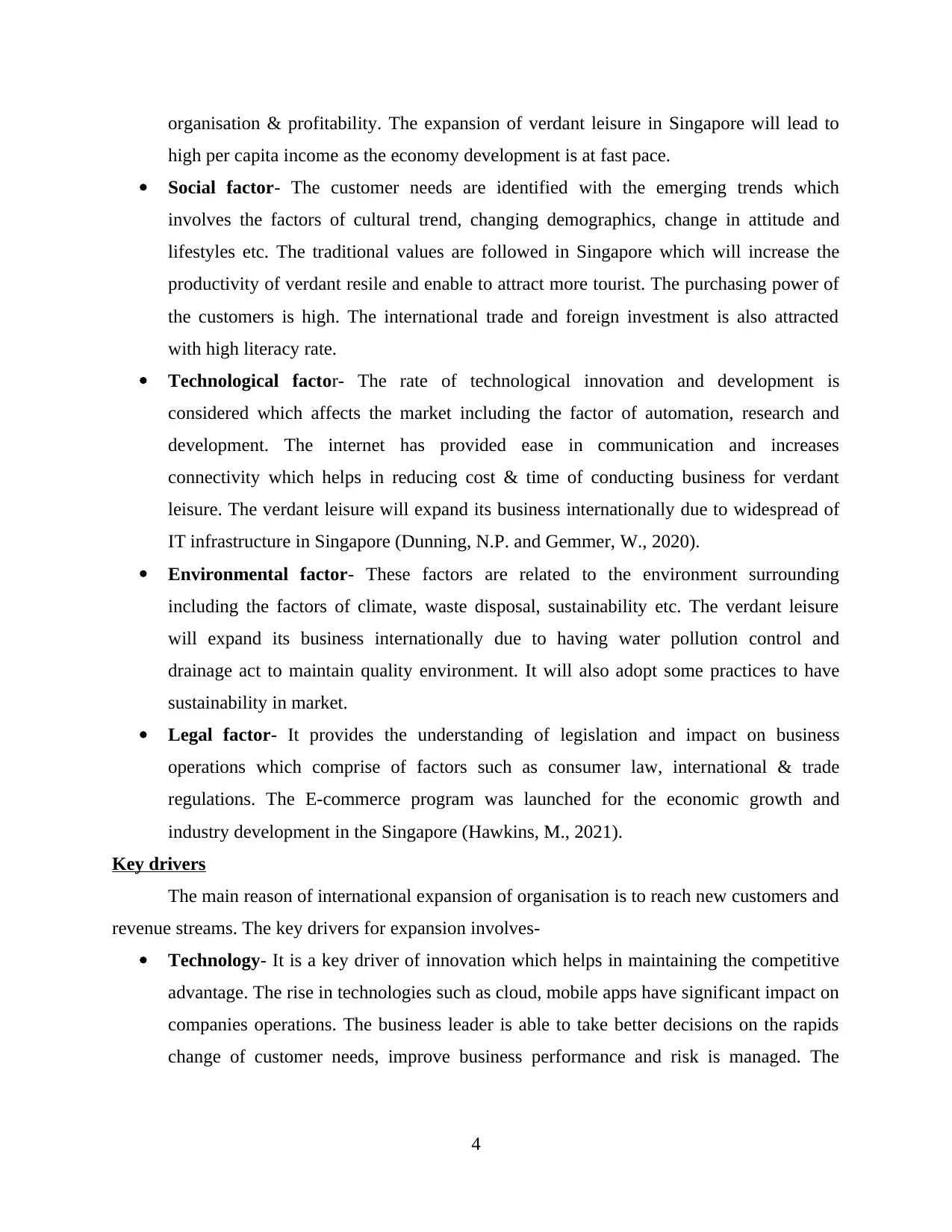
organisation & profitability. The expansion of verdant leisure in Singapore will lead to
high per capita income as the economy development is at fast pace.
Social factor- The customer needs are identified with the emerging trends which
involves the factors of cultural trend, changing demographics, change in attitude and
lifestyles etc. The traditional values are followed in Singapore which will increase the
productivity of verdant resile and enable to attract more tourist. The purchasing power of
the customers is high. The international trade and foreign investment is also attracted
with high literacy rate.
Technological factor- The rate of technological innovation and development is
considered which affects the market including the factor of automation, research and
development. The internet has provided ease in communication and increases
connectivity which helps in reducing cost & time of conducting business for verdant
leisure. The verdant leisure will expand its business internationally due to widespread of
IT infrastructure in Singapore (Dunning, N.P. and Gemmer, W., 2020).
Environmental factor- These factors are related to the environment surrounding
including the factors of climate, waste disposal, sustainability etc. The verdant leisure
will expand its business internationally due to having water pollution control and
drainage act to maintain quality environment. It will also adopt some practices to have
sustainability in market.
Legal factor- It provides the understanding of legislation and impact on business
operations which comprise of factors such as consumer law, international & trade
regulations. The E-commerce program was launched for the economic growth and
industry development in the Singapore (Hawkins, M., 2021).
Key drivers
The main reason of international expansion of organisation is to reach new customers and
revenue streams. The key drivers for expansion involves-
Technology- It is a key driver of innovation which helps in maintaining the competitive
advantage. The rise in technologies such as cloud, mobile apps have significant impact on
companies operations. The business leader is able to take better decisions on the rapids
change of customer needs, improve business performance and risk is managed. The
4
high per capita income as the economy development is at fast pace.
Social factor- The customer needs are identified with the emerging trends which
involves the factors of cultural trend, changing demographics, change in attitude and
lifestyles etc. The traditional values are followed in Singapore which will increase the
productivity of verdant resile and enable to attract more tourist. The purchasing power of
the customers is high. The international trade and foreign investment is also attracted
with high literacy rate.
Technological factor- The rate of technological innovation and development is
considered which affects the market including the factor of automation, research and
development. The internet has provided ease in communication and increases
connectivity which helps in reducing cost & time of conducting business for verdant
leisure. The verdant leisure will expand its business internationally due to widespread of
IT infrastructure in Singapore (Dunning, N.P. and Gemmer, W., 2020).
Environmental factor- These factors are related to the environment surrounding
including the factors of climate, waste disposal, sustainability etc. The verdant leisure
will expand its business internationally due to having water pollution control and
drainage act to maintain quality environment. It will also adopt some practices to have
sustainability in market.
Legal factor- It provides the understanding of legislation and impact on business
operations which comprise of factors such as consumer law, international & trade
regulations. The E-commerce program was launched for the economic growth and
industry development in the Singapore (Hawkins, M., 2021).
Key drivers
The main reason of international expansion of organisation is to reach new customers and
revenue streams. The key drivers for expansion involves-
Technology- It is a key driver of innovation which helps in maintaining the competitive
advantage. The rise in technologies such as cloud, mobile apps have significant impact on
companies operations. The business leader is able to take better decisions on the rapids
change of customer needs, improve business performance and risk is managed. The
4
Paraphrase This Document
Need a fresh take? Get an instant paraphrase of this document with our AI Paraphraser
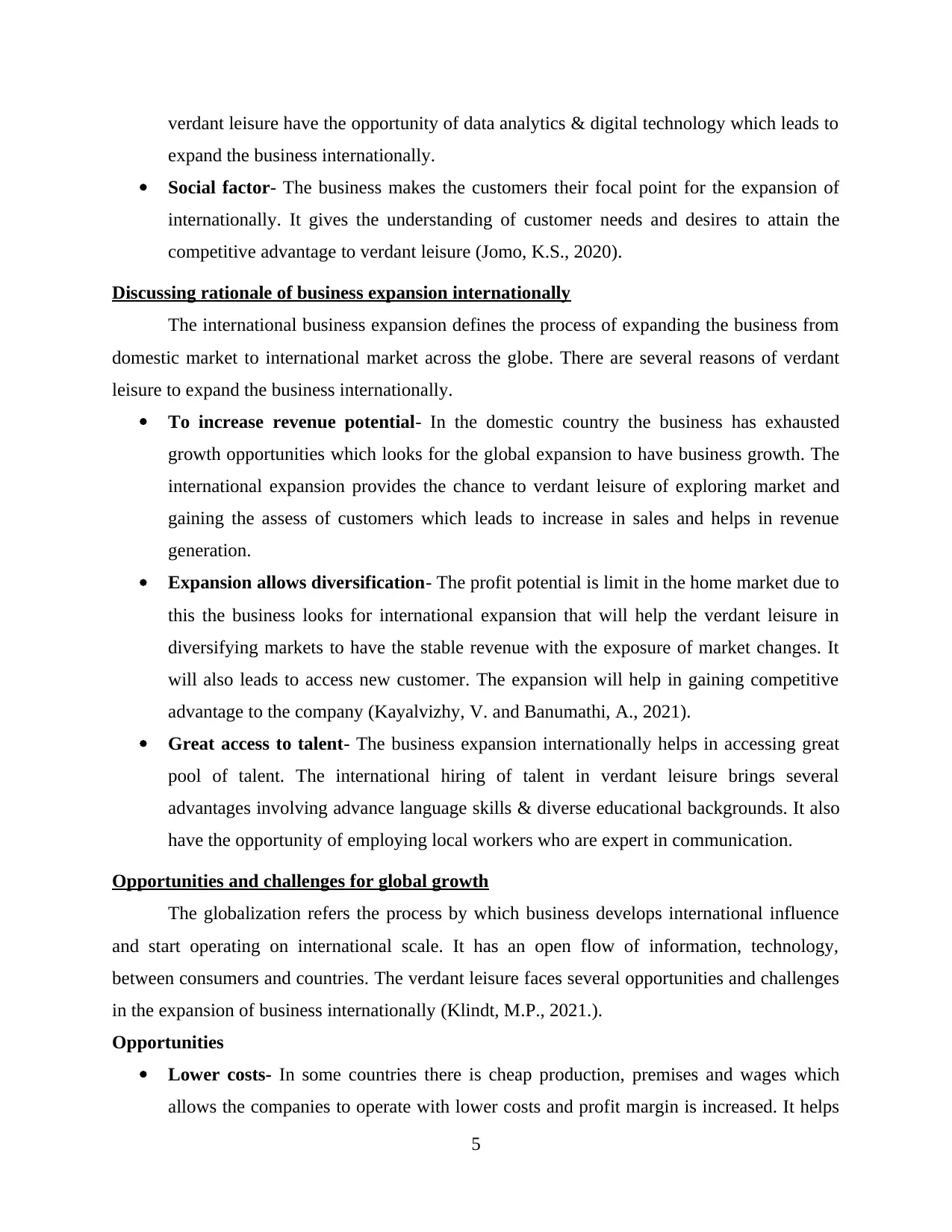
verdant leisure have the opportunity of data analytics & digital technology which leads to
expand the business internationally.
Social factor- The business makes the customers their focal point for the expansion of
internationally. It gives the understanding of customer needs and desires to attain the
competitive advantage to verdant leisure (Jomo, K.S., 2020).
Discussing rationale of business expansion internationally
The international business expansion defines the process of expanding the business from
domestic market to international market across the globe. There are several reasons of verdant
leisure to expand the business internationally.
To increase revenue potential- In the domestic country the business has exhausted
growth opportunities which looks for the global expansion to have business growth. The
international expansion provides the chance to verdant leisure of exploring market and
gaining the assess of customers which leads to increase in sales and helps in revenue
generation.
Expansion allows diversification- The profit potential is limit in the home market due to
this the business looks for international expansion that will help the verdant leisure in
diversifying markets to have the stable revenue with the exposure of market changes. It
will also leads to access new customer. The expansion will help in gaining competitive
advantage to the company (Kayalvizhy, V. and Banumathi, A., 2021).
Great access to talent- The business expansion internationally helps in accessing great
pool of talent. The international hiring of talent in verdant leisure brings several
advantages involving advance language skills & diverse educational backgrounds. It also
have the opportunity of employing local workers who are expert in communication.
Opportunities and challenges for global growth
The globalization refers the process by which business develops international influence
and start operating on international scale. It has an open flow of information, technology,
between consumers and countries. The verdant leisure faces several opportunities and challenges
in the expansion of business internationally (Klindt, M.P., 2021.).
Opportunities
Lower costs- In some countries there is cheap production, premises and wages which
allows the companies to operate with lower costs and profit margin is increased. It helps
5
expand the business internationally.
Social factor- The business makes the customers their focal point for the expansion of
internationally. It gives the understanding of customer needs and desires to attain the
competitive advantage to verdant leisure (Jomo, K.S., 2020).
Discussing rationale of business expansion internationally
The international business expansion defines the process of expanding the business from
domestic market to international market across the globe. There are several reasons of verdant
leisure to expand the business internationally.
To increase revenue potential- In the domestic country the business has exhausted
growth opportunities which looks for the global expansion to have business growth. The
international expansion provides the chance to verdant leisure of exploring market and
gaining the assess of customers which leads to increase in sales and helps in revenue
generation.
Expansion allows diversification- The profit potential is limit in the home market due to
this the business looks for international expansion that will help the verdant leisure in
diversifying markets to have the stable revenue with the exposure of market changes. It
will also leads to access new customer. The expansion will help in gaining competitive
advantage to the company (Kayalvizhy, V. and Banumathi, A., 2021).
Great access to talent- The business expansion internationally helps in accessing great
pool of talent. The international hiring of talent in verdant leisure brings several
advantages involving advance language skills & diverse educational backgrounds. It also
have the opportunity of employing local workers who are expert in communication.
Opportunities and challenges for global growth
The globalization refers the process by which business develops international influence
and start operating on international scale. It has an open flow of information, technology,
between consumers and countries. The verdant leisure faces several opportunities and challenges
in the expansion of business internationally (Klindt, M.P., 2021.).
Opportunities
Lower costs- In some countries there is cheap production, premises and wages which
allows the companies to operate with lower costs and profit margin is increased. It helps
5
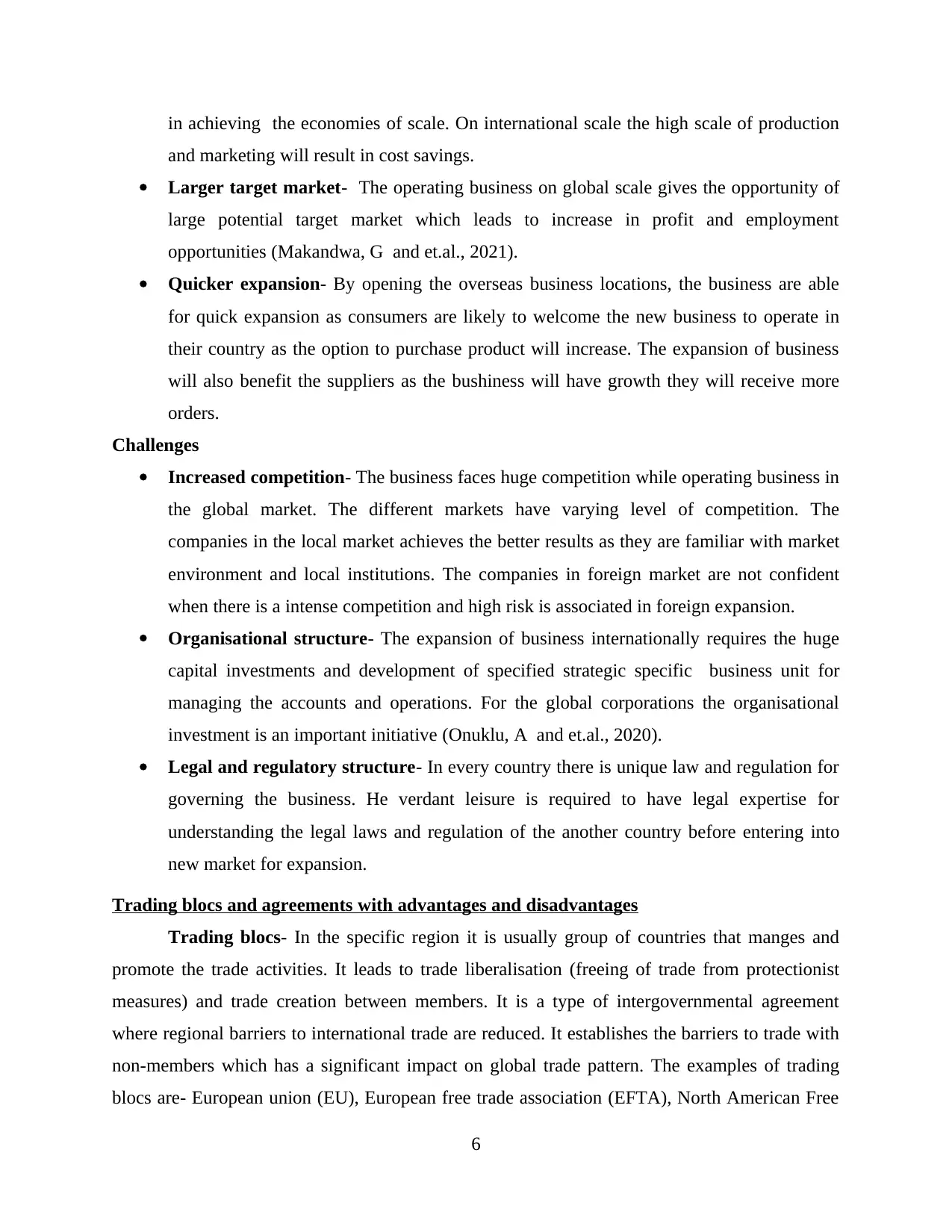
in achieving the economies of scale. On international scale the high scale of production
and marketing will result in cost savings.
Larger target market- The operating business on global scale gives the opportunity of
large potential target market which leads to increase in profit and employment
opportunities (Makandwa, G and et.al., 2021).
Quicker expansion- By opening the overseas business locations, the business are able
for quick expansion as consumers are likely to welcome the new business to operate in
their country as the option to purchase product will increase. The expansion of business
will also benefit the suppliers as the bushiness will have growth they will receive more
orders.
Challenges
Increased competition- The business faces huge competition while operating business in
the global market. The different markets have varying level of competition. The
companies in the local market achieves the better results as they are familiar with market
environment and local institutions. The companies in foreign market are not confident
when there is a intense competition and high risk is associated in foreign expansion.
Organisational structure- The expansion of business internationally requires the huge
capital investments and development of specified strategic specific business unit for
managing the accounts and operations. For the global corporations the organisational
investment is an important initiative (Onuklu, A and et.al., 2020).
Legal and regulatory structure- In every country there is unique law and regulation for
governing the business. He verdant leisure is required to have legal expertise for
understanding the legal laws and regulation of the another country before entering into
new market for expansion.
Trading blocs and agreements with advantages and disadvantages
Trading blocs- In the specific region it is usually group of countries that manges and
promote the trade activities. It leads to trade liberalisation (freeing of trade from protectionist
measures) and trade creation between members. It is a type of intergovernmental agreement
where regional barriers to international trade are reduced. It establishes the barriers to trade with
non-members which has a significant impact on global trade pattern. The examples of trading
blocs are- European union (EU), European free trade association (EFTA), North American Free
6
and marketing will result in cost savings.
Larger target market- The operating business on global scale gives the opportunity of
large potential target market which leads to increase in profit and employment
opportunities (Makandwa, G and et.al., 2021).
Quicker expansion- By opening the overseas business locations, the business are able
for quick expansion as consumers are likely to welcome the new business to operate in
their country as the option to purchase product will increase. The expansion of business
will also benefit the suppliers as the bushiness will have growth they will receive more
orders.
Challenges
Increased competition- The business faces huge competition while operating business in
the global market. The different markets have varying level of competition. The
companies in the local market achieves the better results as they are familiar with market
environment and local institutions. The companies in foreign market are not confident
when there is a intense competition and high risk is associated in foreign expansion.
Organisational structure- The expansion of business internationally requires the huge
capital investments and development of specified strategic specific business unit for
managing the accounts and operations. For the global corporations the organisational
investment is an important initiative (Onuklu, A and et.al., 2020).
Legal and regulatory structure- In every country there is unique law and regulation for
governing the business. He verdant leisure is required to have legal expertise for
understanding the legal laws and regulation of the another country before entering into
new market for expansion.
Trading blocs and agreements with advantages and disadvantages
Trading blocs- In the specific region it is usually group of countries that manges and
promote the trade activities. It leads to trade liberalisation (freeing of trade from protectionist
measures) and trade creation between members. It is a type of intergovernmental agreement
where regional barriers to international trade are reduced. It establishes the barriers to trade with
non-members which has a significant impact on global trade pattern. The examples of trading
blocs are- European union (EU), European free trade association (EFTA), North American Free
6
⊘ This is a preview!⊘
Do you want full access?
Subscribe today to unlock all pages.

Trusted by 1+ million students worldwide
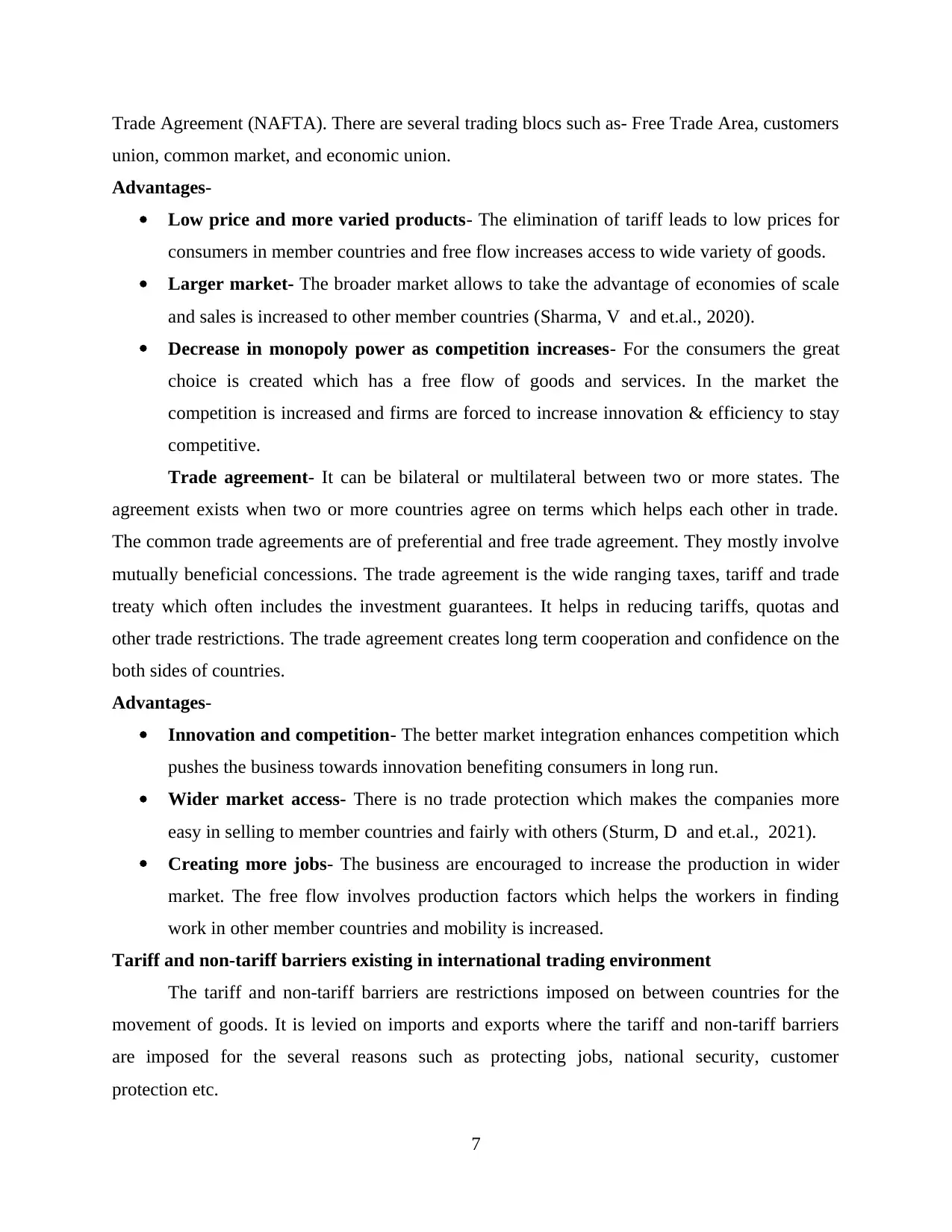
Trade Agreement (NAFTA). There are several trading blocs such as- Free Trade Area, customers
union, common market, and economic union.
Advantages-
Low price and more varied products- The elimination of tariff leads to low prices for
consumers in member countries and free flow increases access to wide variety of goods.
Larger market- The broader market allows to take the advantage of economies of scale
and sales is increased to other member countries (Sharma, V and et.al., 2020).
Decrease in monopoly power as competition increases- For the consumers the great
choice is created which has a free flow of goods and services. In the market the
competition is increased and firms are forced to increase innovation & efficiency to stay
competitive.
Trade agreement- It can be bilateral or multilateral between two or more states. The
agreement exists when two or more countries agree on terms which helps each other in trade.
The common trade agreements are of preferential and free trade agreement. They mostly involve
mutually beneficial concessions. The trade agreement is the wide ranging taxes, tariff and trade
treaty which often includes the investment guarantees. It helps in reducing tariffs, quotas and
other trade restrictions. The trade agreement creates long term cooperation and confidence on the
both sides of countries.
Advantages-
Innovation and competition- The better market integration enhances competition which
pushes the business towards innovation benefiting consumers in long run.
Wider market access- There is no trade protection which makes the companies more
easy in selling to member countries and fairly with others (Sturm, D and et.al., 2021).
Creating more jobs- The business are encouraged to increase the production in wider
market. The free flow involves production factors which helps the workers in finding
work in other member countries and mobility is increased.
Tariff and non-tariff barriers existing in international trading environment
The tariff and non-tariff barriers are restrictions imposed on between countries for the
movement of goods. It is levied on imports and exports where the tariff and non-tariff barriers
are imposed for the several reasons such as protecting jobs, national security, customer
protection etc.
7
union, common market, and economic union.
Advantages-
Low price and more varied products- The elimination of tariff leads to low prices for
consumers in member countries and free flow increases access to wide variety of goods.
Larger market- The broader market allows to take the advantage of economies of scale
and sales is increased to other member countries (Sharma, V and et.al., 2020).
Decrease in monopoly power as competition increases- For the consumers the great
choice is created which has a free flow of goods and services. In the market the
competition is increased and firms are forced to increase innovation & efficiency to stay
competitive.
Trade agreement- It can be bilateral or multilateral between two or more states. The
agreement exists when two or more countries agree on terms which helps each other in trade.
The common trade agreements are of preferential and free trade agreement. They mostly involve
mutually beneficial concessions. The trade agreement is the wide ranging taxes, tariff and trade
treaty which often includes the investment guarantees. It helps in reducing tariffs, quotas and
other trade restrictions. The trade agreement creates long term cooperation and confidence on the
both sides of countries.
Advantages-
Innovation and competition- The better market integration enhances competition which
pushes the business towards innovation benefiting consumers in long run.
Wider market access- There is no trade protection which makes the companies more
easy in selling to member countries and fairly with others (Sturm, D and et.al., 2021).
Creating more jobs- The business are encouraged to increase the production in wider
market. The free flow involves production factors which helps the workers in finding
work in other member countries and mobility is increased.
Tariff and non-tariff barriers existing in international trading environment
The tariff and non-tariff barriers are restrictions imposed on between countries for the
movement of goods. It is levied on imports and exports where the tariff and non-tariff barriers
are imposed for the several reasons such as protecting jobs, national security, customer
protection etc.
7
Paraphrase This Document
Need a fresh take? Get an instant paraphrase of this document with our AI Paraphraser
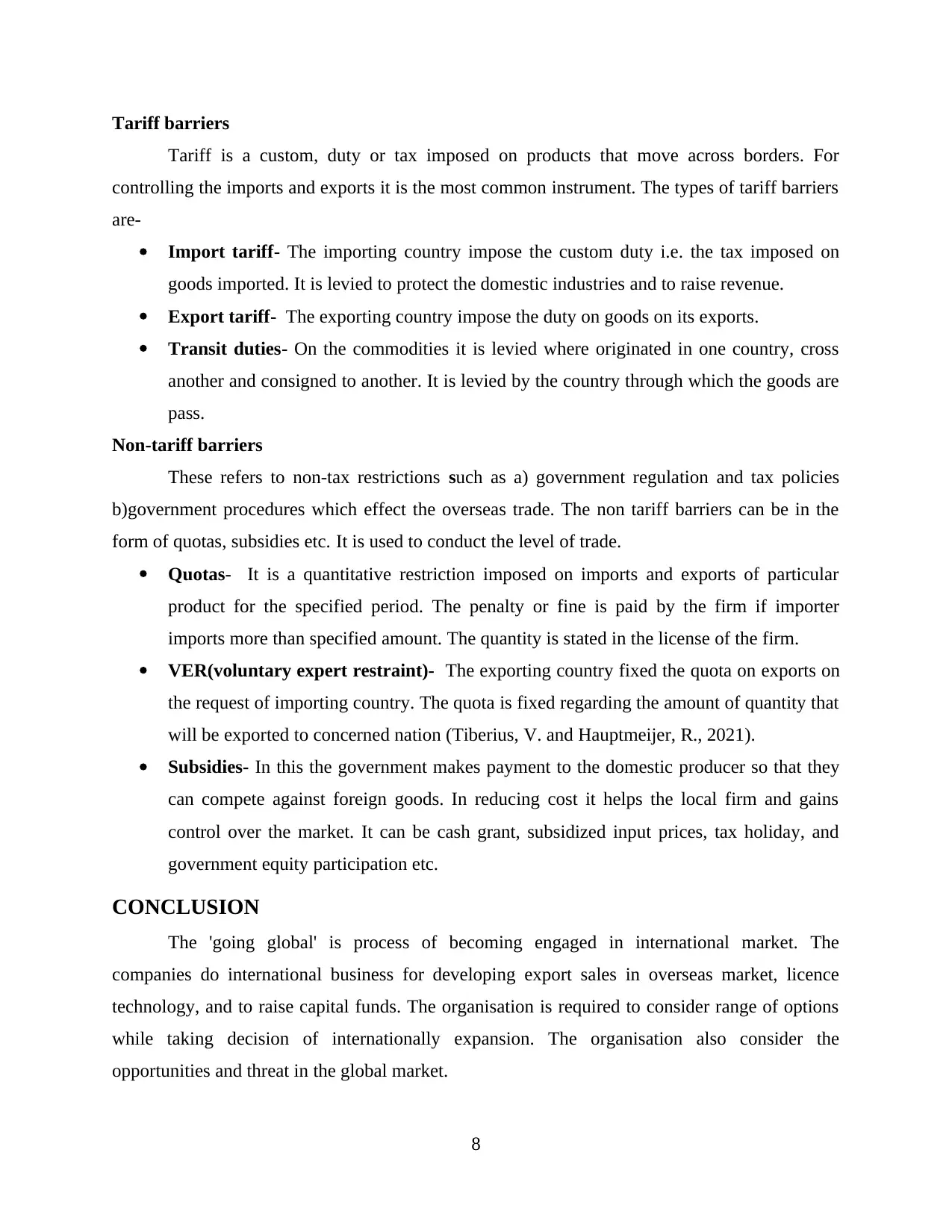
Tariff barriers
Tariff is a custom, duty or tax imposed on products that move across borders. For
controlling the imports and exports it is the most common instrument. The types of tariff barriers
are-
Import tariff- The importing country impose the custom duty i.e. the tax imposed on
goods imported. It is levied to protect the domestic industries and to raise revenue.
Export tariff- The exporting country impose the duty on goods on its exports.
Transit duties- On the commodities it is levied where originated in one country, cross
another and consigned to another. It is levied by the country through which the goods are
pass.
Non-tariff barriers
These refers to non-tax restrictions such as a) government regulation and tax policies
b)government procedures which effect the overseas trade. The non tariff barriers can be in the
form of quotas, subsidies etc. It is used to conduct the level of trade.
Quotas- It is a quantitative restriction imposed on imports and exports of particular
product for the specified period. The penalty or fine is paid by the firm if importer
imports more than specified amount. The quantity is stated in the license of the firm.
VER(voluntary expert restraint)- The exporting country fixed the quota on exports on
the request of importing country. The quota is fixed regarding the amount of quantity that
will be exported to concerned nation (Tiberius, V. and Hauptmeijer, R., 2021).
Subsidies- In this the government makes payment to the domestic producer so that they
can compete against foreign goods. In reducing cost it helps the local firm and gains
control over the market. It can be cash grant, subsidized input prices, tax holiday, and
government equity participation etc.
CONCLUSION
The 'going global' is process of becoming engaged in international market. The
companies do international business for developing export sales in overseas market, licence
technology, and to raise capital funds. The organisation is required to consider range of options
while taking decision of internationally expansion. The organisation also consider the
opportunities and threat in the global market.
8
Tariff is a custom, duty or tax imposed on products that move across borders. For
controlling the imports and exports it is the most common instrument. The types of tariff barriers
are-
Import tariff- The importing country impose the custom duty i.e. the tax imposed on
goods imported. It is levied to protect the domestic industries and to raise revenue.
Export tariff- The exporting country impose the duty on goods on its exports.
Transit duties- On the commodities it is levied where originated in one country, cross
another and consigned to another. It is levied by the country through which the goods are
pass.
Non-tariff barriers
These refers to non-tax restrictions such as a) government regulation and tax policies
b)government procedures which effect the overseas trade. The non tariff barriers can be in the
form of quotas, subsidies etc. It is used to conduct the level of trade.
Quotas- It is a quantitative restriction imposed on imports and exports of particular
product for the specified period. The penalty or fine is paid by the firm if importer
imports more than specified amount. The quantity is stated in the license of the firm.
VER(voluntary expert restraint)- The exporting country fixed the quota on exports on
the request of importing country. The quota is fixed regarding the amount of quantity that
will be exported to concerned nation (Tiberius, V. and Hauptmeijer, R., 2021).
Subsidies- In this the government makes payment to the domestic producer so that they
can compete against foreign goods. In reducing cost it helps the local firm and gains
control over the market. It can be cash grant, subsidized input prices, tax holiday, and
government equity participation etc.
CONCLUSION
The 'going global' is process of becoming engaged in international market. The
companies do international business for developing export sales in overseas market, licence
technology, and to raise capital funds. The organisation is required to consider range of options
while taking decision of internationally expansion. The organisation also consider the
opportunities and threat in the global market.
8

PART 2
Covered in the brochure
9
Covered in the brochure
9
⊘ This is a preview!⊘
Do you want full access?
Subscribe today to unlock all pages.

Trusted by 1+ million students worldwide
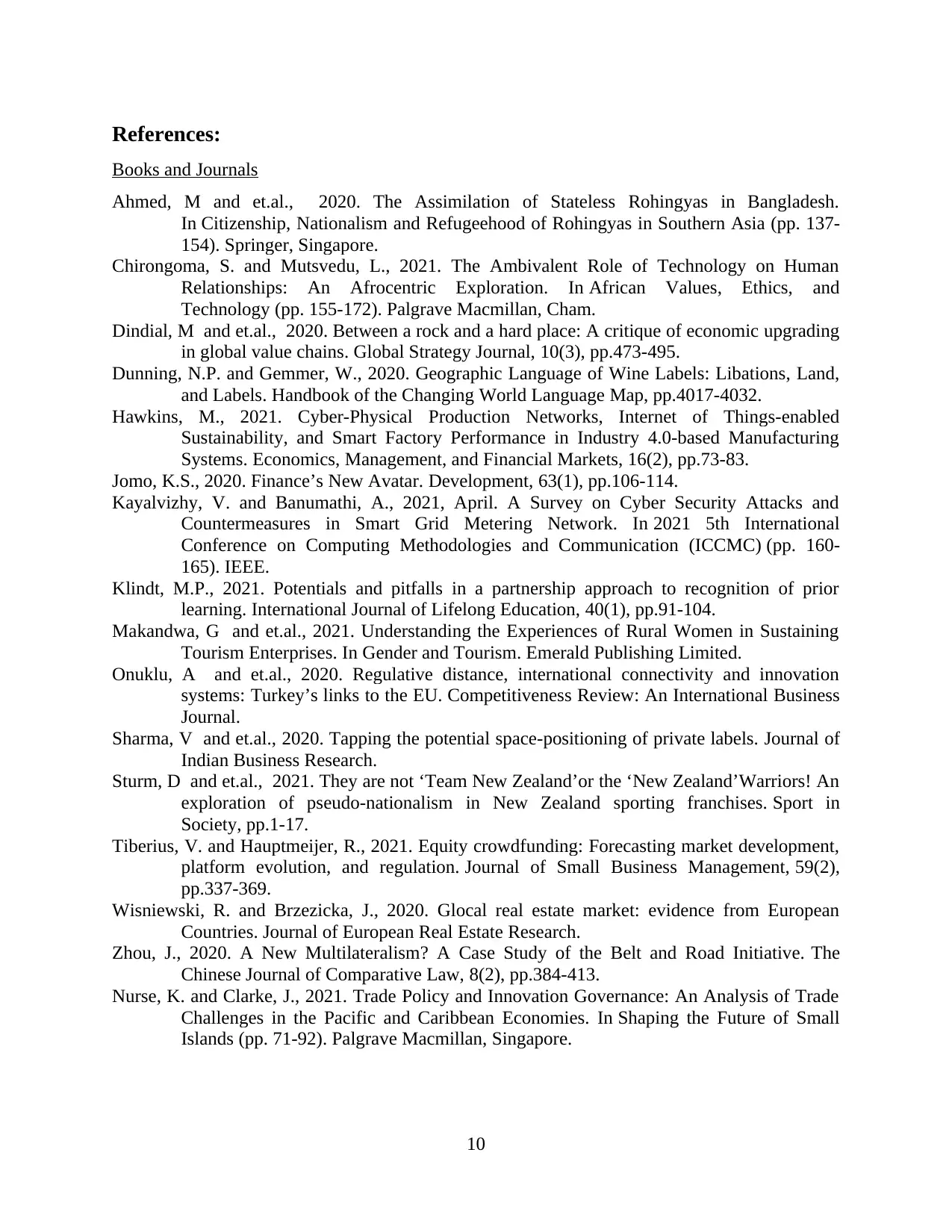
References:
Books and Journals
Ahmed, M and et.al., 2020. The Assimilation of Stateless Rohingyas in Bangladesh.
In Citizenship, Nationalism and Refugeehood of Rohingyas in Southern Asia (pp. 137-
154). Springer, Singapore.
Chirongoma, S. and Mutsvedu, L., 2021. The Ambivalent Role of Technology on Human
Relationships: An Afrocentric Exploration. In African Values, Ethics, and
Technology (pp. 155-172). Palgrave Macmillan, Cham.
Dindial, M and et.al., 2020. Between a rock and a hard place: A critique of economic upgrading
in global value chains. Global Strategy Journal, 10(3), pp.473-495.
Dunning, N.P. and Gemmer, W., 2020. Geographic Language of Wine Labels: Libations, Land,
and Labels. Handbook of the Changing World Language Map, pp.4017-4032.
Hawkins, M., 2021. Cyber-Physical Production Networks, Internet of Things-enabled
Sustainability, and Smart Factory Performance in Industry 4.0-based Manufacturing
Systems. Economics, Management, and Financial Markets, 16(2), pp.73-83.
Jomo, K.S., 2020. Finance’s New Avatar. Development, 63(1), pp.106-114.
Kayalvizhy, V. and Banumathi, A., 2021, April. A Survey on Cyber Security Attacks and
Countermeasures in Smart Grid Metering Network. In 2021 5th International
Conference on Computing Methodologies and Communication (ICCMC) (pp. 160-
165). IEEE.
Klindt, M.P., 2021. Potentials and pitfalls in a partnership approach to recognition of prior
learning. International Journal of Lifelong Education, 40(1), pp.91-104.
Makandwa, G and et.al., 2021. Understanding the Experiences of Rural Women in Sustaining
Tourism Enterprises. In Gender and Tourism. Emerald Publishing Limited.
Onuklu, A and et.al., 2020. Regulative distance, international connectivity and innovation
systems: Turkey’s links to the EU. Competitiveness Review: An International Business
Journal.
Sharma, V and et.al., 2020. Tapping the potential space-positioning of private labels. Journal of
Indian Business Research.
Sturm, D and et.al., 2021. They are not ‘Team New Zealand’or the ‘New Zealand’Warriors! An
exploration of pseudo-nationalism in New Zealand sporting franchises. Sport in
Society, pp.1-17.
Tiberius, V. and Hauptmeijer, R., 2021. Equity crowdfunding: Forecasting market development,
platform evolution, and regulation. Journal of Small Business Management, 59(2),
pp.337-369.
Wisniewski, R. and Brzezicka, J., 2020. Glocal real estate market: evidence from European
Countries. Journal of European Real Estate Research.
Zhou, J., 2020. A New Multilateralism? A Case Study of the Belt and Road Initiative. The
Chinese Journal of Comparative Law, 8(2), pp.384-413.
Nurse, K. and Clarke, J., 2021. Trade Policy and Innovation Governance: An Analysis of Trade
Challenges in the Pacific and Caribbean Economies. In Shaping the Future of Small
Islands (pp. 71-92). Palgrave Macmillan, Singapore.
10
Books and Journals
Ahmed, M and et.al., 2020. The Assimilation of Stateless Rohingyas in Bangladesh.
In Citizenship, Nationalism and Refugeehood of Rohingyas in Southern Asia (pp. 137-
154). Springer, Singapore.
Chirongoma, S. and Mutsvedu, L., 2021. The Ambivalent Role of Technology on Human
Relationships: An Afrocentric Exploration. In African Values, Ethics, and
Technology (pp. 155-172). Palgrave Macmillan, Cham.
Dindial, M and et.al., 2020. Between a rock and a hard place: A critique of economic upgrading
in global value chains. Global Strategy Journal, 10(3), pp.473-495.
Dunning, N.P. and Gemmer, W., 2020. Geographic Language of Wine Labels: Libations, Land,
and Labels. Handbook of the Changing World Language Map, pp.4017-4032.
Hawkins, M., 2021. Cyber-Physical Production Networks, Internet of Things-enabled
Sustainability, and Smart Factory Performance in Industry 4.0-based Manufacturing
Systems. Economics, Management, and Financial Markets, 16(2), pp.73-83.
Jomo, K.S., 2020. Finance’s New Avatar. Development, 63(1), pp.106-114.
Kayalvizhy, V. and Banumathi, A., 2021, April. A Survey on Cyber Security Attacks and
Countermeasures in Smart Grid Metering Network. In 2021 5th International
Conference on Computing Methodologies and Communication (ICCMC) (pp. 160-
165). IEEE.
Klindt, M.P., 2021. Potentials and pitfalls in a partnership approach to recognition of prior
learning. International Journal of Lifelong Education, 40(1), pp.91-104.
Makandwa, G and et.al., 2021. Understanding the Experiences of Rural Women in Sustaining
Tourism Enterprises. In Gender and Tourism. Emerald Publishing Limited.
Onuklu, A and et.al., 2020. Regulative distance, international connectivity and innovation
systems: Turkey’s links to the EU. Competitiveness Review: An International Business
Journal.
Sharma, V and et.al., 2020. Tapping the potential space-positioning of private labels. Journal of
Indian Business Research.
Sturm, D and et.al., 2021. They are not ‘Team New Zealand’or the ‘New Zealand’Warriors! An
exploration of pseudo-nationalism in New Zealand sporting franchises. Sport in
Society, pp.1-17.
Tiberius, V. and Hauptmeijer, R., 2021. Equity crowdfunding: Forecasting market development,
platform evolution, and regulation. Journal of Small Business Management, 59(2),
pp.337-369.
Wisniewski, R. and Brzezicka, J., 2020. Glocal real estate market: evidence from European
Countries. Journal of European Real Estate Research.
Zhou, J., 2020. A New Multilateralism? A Case Study of the Belt and Road Initiative. The
Chinese Journal of Comparative Law, 8(2), pp.384-413.
Nurse, K. and Clarke, J., 2021. Trade Policy and Innovation Governance: An Analysis of Trade
Challenges in the Pacific and Caribbean Economies. In Shaping the Future of Small
Islands (pp. 71-92). Palgrave Macmillan, Singapore.
10
1 out of 10
Related Documents
Your All-in-One AI-Powered Toolkit for Academic Success.
+13062052269
info@desklib.com
Available 24*7 on WhatsApp / Email
![[object Object]](/_next/static/media/star-bottom.7253800d.svg)
Unlock your academic potential
Copyright © 2020–2025 A2Z Services. All Rights Reserved. Developed and managed by ZUCOL.



